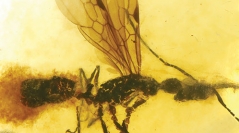

 Comptes Rendus Palevol
20 (2) - Pages 21-27
Comptes Rendus Palevol
20 (2) - Pages 21-27The ponerine ant Anochetus miosumatrensis Ngô-Muller, Garrouste & Nel, n. sp. is described from a fossil alate female preserved in amber of Sumatra which is reputedly of Miocene age. On the basis of the general morphology, the fossil could be attributed to the extant Sumatran species group risii Brown, 1978. By comparing with the living environment of the extant species, this ant probably lived in a warm humid forest where it was trapped in dipterocarpacean resin during nuptial flight. Until now, the known Cenozoic distribution of the genus Anochetus was restricted to the Neotropical region. Thus A. miosumatrensis Ngô-Muller, Garrouste & Nel, n. sp. brings the first record of the genus from Indomalaya biogeographic region.
Insecta, Hymenoptera, Formicidae, Ponerinae, new species, Sumatran amber